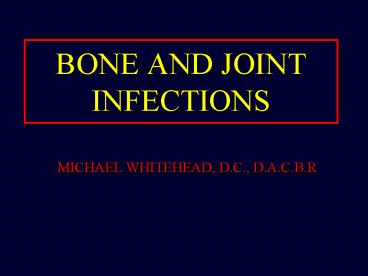BONE AND JOINT INFECTIONS - PowerPoint PPT Presentation
1 / 28
Title:
BONE AND JOINT INFECTIONS
Description:
Contamination of cutaneous, subcutaneous, tendinous, ... Mycobacterium tuberculosis. Syphilis. Treponema pallidum. Fungal. Actinomycosis, Coccidioidomycosis ... – PowerPoint PPT presentation
Number of Views:154
Avg rating:3.0/5.0
Title: BONE AND JOINT INFECTIONS
1
BONE AND JOINT INFECTIONS
- MICHAEL WHITEHEAD, D.C., D.A.C.B.R
2
TERMINOLOGY
- Osteomyelitis
- Infection of bone and marrow
- Septic Arthritis
- Implies a septic process of the joint itself.
- Soft Tissue Infection
- Contamination of cutaneous, subcutaneous,
tendinous, ligamentous and bursal structures.
3
TERMINOLOGY
- Two Types of Osteomyelitis And Septic Arthritis
- Suppurative Osteomyelitis
- Non-suppurative Osteomyelitis
4
TERMINOLOGY
- Suppurative Osteomyelitis
- Based on clinical presentation.
- Acute
- Subacute
- Chronic
5
RISK FACTORS
- Immunosuppressed Individuals
- Alcoholics
- Newborns
- IV drug users
- Diabetes
- Sickle-Cell
- Post surgical
- Vascular Insufficiency
6
MICROORGANISMS
- Suppurative Osteomyelitis
- Staphylococcus aureus (M/C)
- Streptococcus pyogenes
- Streptococcus pneumoniae
- Pseudomonas aeruginosa
- Salmonella
- Haemophilus influenzae
7
MICROORGANISMS
- Non-Suppurative Osteomyelitis
- Tuberculosis
- Mycobacterium tuberculosis
- Syphilis
- Treponema pallidum
- Fungal
- Actinomycosis, Coccidioidomycosis
8
ROUTES OF CONTAMINATION
- Hematogenous
- Contiguous Source
- Direct Implantation
- Postoperative Infection
9
SKELETAL LOCATIONS
- Appendicular skeleton most often affected.
- Femur most common bone involved
- Tibia
- Humerus
- Radius
10
CLINICAL MANIFESTATIONS
- M/C age group is 2-12 years of age
- More common in males
- Differences in the clinical and radiographic
presentation and course of hematologic
osteomyelitis in the child, infant and adult
exists
11
CLINICAL MANIFESTATIONS
- Childhood and infancy
- Sudden onset of high fever
- Localized pain and swelling
- Chills
- Loss of limb function
- Findings may be less dramatic in the infant
12
CLINICAL MANIFESTATIONS
- Adult
- May have a more insidious onset with a longer
period between the appearance of S/S and the
diagnosis - Fever and malaise
- Edema and erythema and pain
13
CLINICAL MANIFESTATIONS
- Frequently associated with pre-existing
infections of other systems - Genitourinary
- Skin
- Respiratory
14
CLINICAL MANIFESTATIONS
- Mainliners Syndrome
- M/C microorganisms are Staphylococcus aureus and
Pseudomonias - Other gram-negative organisms
- Frequently involves the S joints.
15
LABORATORY FEATURES
- Elevated white cell count
- Schilling shift to the left
- Elevated ESR
- Positive blood cultures with hematogenous (50)
16
PATHOLOGIC FEATURES
- Vascular Supply
- Infantile Pattern
- Fetal vascular compartments may persist up to age
of 1 year - Vessels may penetrate the physis
- Higher incidence of septic arthritis
17
PATHOLOGIC FEATURES
- Vascular Supply
- Childhood Pattern
- 1 year until time open physis fuses
- Epiphyseal supply is separate
- Hematogenous osteomyelitis affects more often the
metaphysis and not physis or epiphysis
18
PATHOLOGIC FEATURES
- Vascular Supply
- Adult Pattern
- Metaphyseal vessels gradually penetrate the
physis re establishing communication with the
bone end - Increased incidence of septic arthritis secondary
to osteomyelitis
19
PATHOPHYSIOLOGY
- Hematogenous Dissemination
- Mechanism
- Usually direct extension from extravascular sites
of infection ?bloodstream - Bacteremia
20
PATHOPHYSIOLOGY
- Implantation of organism medullary tissue
- Vascular and cellular response
- Active hyperemia?focal osteolysis
- Suppurative edema? intramedullary
pressure?infarction - Reaches the subperiosteal space? periosteal
response
21
PATHOPHYSIOLOGY
- Sequestrum
- Necrotic bone due to infarction
- Involucrum
- Bony collar from periosteal new bone
- Cloaca
- Defect in involucrum? discharge
- Most often assoc. with chronic osteomyelitis
- Marjolins ulcer squamous cell carcinoma
22
IMAGING FEATURES
- Early Detection
- MRI
- Bone Scintigraphy
- Conventional Radiography
- Latent period Time before osseous changes are
evident radiographically - Extremity About 10 days
- Spine About 21 days
23
IMAGING FEATURES
- Extremity
- Soft tissue changes are earliest findings
- M/C in the metaphysis
- Moth-eaten or permeative pattern of destruction,
may see focal osteopenia - Medullary and cortical destruction
- Periosteal response, Codmans triangle
24
IMAGING FEATURES
- Extremity Late Changes
- Sequestration
- Involucrum
- Cloaca
- Sclerosis
25
IMAGING FEATURES
- Spine lt20 yoa
- Initial disc involvement ? disc narrowing
- Paraspinal edema, endplate destruction,
osteolysis - Spine Adult
- Usually begins vertebral body involves disc
secondarly - Vertebrae destruction, collapse, paraspinal
swelling - Bony ankylosis may be seen
26
BRODIES ABSCESS
- General Comments
- Localized, aborted suppurative osteomyelitis
- Staph aureus m/c
- Often associated with hx of previous infection
- Localized pain worst at night relief by aspirin
- M/C young male children
- Radiographic Features
- M/C metaphysis, distal tibia, prox tibia, fibula,
dist radius - Oval, elliptical or serpiginous radiolucency with
rim of sclerosis
27
SEPTIC ARTHRITIS
- General Comments
- M/C below age 30, monoarticular m/c
- Staph aureus m/c
- Restricted ROM, erythema, fever, labs typical
infection - M/C knee and hip
- Radiographic Features
- Soft tissue changes in about 3 days
- Loss of subchondral white line, juxta
periarticular osteopenia, destruction of
articular ends - Bony or fibrous ankylosis
28
TUBERCULAR SPONDYLITIS
- General Comments
- Radiographic Features

